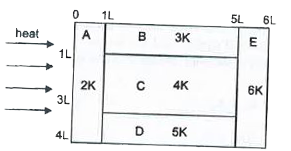According to Newton's law of cooling, the rate of cooling of a body is proportional to (Δθ)n, where Δθ is the difference of the temperature of the body and the surroundings, and n is equal to : Solution in Kannada
1
3
2
4
The correct Answer is:A
According to Newton.s law of cooling
Rate of cooling ∝(T−T0)1
∴n=1
Correct choice is (a).
Topper's Solved these Questions
- BOOK - MODERN PUBLICATIONCHAPTER - TRANSFERENCE OF HEAT EXERCISE - Multiple Choice Questions (Level - II)49videos
TRANSFERENCE OF HEAT
- BOOK - MODERN PUBLICATIONCHAPTER - TRANSFERENCE OF HEAT EXERCISE - Multiple Choice Questions (Level - III) Questions From AIEEE/JEE Examination)5videos
TRANSFERENCE OF HEAT
- BOOK - MODERN PUBLICATIONCHAPTER - SOLIDS & SEMICONDUCTOR DEVICESEXERCISE - Revision Test28videos
SOLIDS & SEMICONDUCTOR DEVICES
- BOOK - MODERN PUBLICATIONCHAPTER - UNIFORM CIRCULAR MOTIONEXERCISE - Revision Test57videos
UNIFORM CIRCULAR MOTION
Similar Questions
Two vessels of different materials are similar in size and other respects. The same quantity of ice filled in them gets melted in 40 and 70 minutes respectively. The ration of thermal conductivities for the materials of boxes is :
00:58View SolutionA composite block is made of slabs A,B,C,D and E of different thermal conductivities (given in terms of a constant K) and sizes (given in terms of length, L) as shown in the figure. All slabs are of same width. Heat 'Q' flows only from left to right through the blocks.
Then in steady state
 01:36View Solution
01:36View SolutionChoose the forward biased p-n junction :
01:23View SolutionA sphere of mass m is tied to end of a string of length 1 and rotated through the other and along a horizontal circular path with speed . The work done in full horizontal circle is:
01:36View SolutionAccording to Newton's law of cooling, the rate of cooling of a body is proportional to (Δθ)n, where Δθ is the difference of the temperature of the body and the surroundings, and n is equal to
View SolutionAc cording to Newton's law of cooling, the rate of cooling of a body is proportional to (Delta theta)^(n) , where Delta theta is the difference of the temperature of the body and thae surrounding. What is the value of n out of 4,3,2,and 1?
02:33View SolutionAs difference of temperature of body and surroundings increases, rate of cooling
03:25View SolutionAccording to ‘Newton’s Law of cooling’, the rate of cooling of a body is proportional to the
01:54View SolutionAccording to Newton's law of cooling, the rate of cooling of a body in air is proportional to the difference between the temperature of the body and the temperature of the surrounding air. If the air temperature is 20∘C and the body cools for 20 minutes from 140∘C→80∘C, then the temperature will be 50∘C in
01:54View Solutionन्यूटन के शीतलन नियम के अनुसार किसी वस्तु के ठंडा होने की दर (Δθ)n के अनुक्रमानुपाती होती है | जहाँ Δθ वस्तु और वातावरण के ताप का अंतर है | का मान है -
View SolutionAccording to Newton’s law of cooling, the rate of cooling of a body is proportional to (Deltatheta)^(n) , where Deltatheta is the difference of the temperature of the body and the surrounding, and n is equal to :
02:06View SolutionAccording to Newton's law of cooling, the rate of cooling of a body is proportional to (Deltatheta)^(n),"where "Deltatheta is difference of temperature of body and surroundings, and n is equal to
01:47View SolutionAccording to Newton's law of cooling, the rate of cooling of a body is proportional to (Δθ)n,where Δθ is difference of temperature of body and surroundings, and n is equal to
05:38View SolutionAccording to Newton's law of cooling, the rate of cooling of a body is proportional to (Delta theta)^(n) , where Delta theta is difference of temperature of body and surroundings, and n is equal to
01:19View SolutionAc cording to Newton's law of cooling, the rate of cooling of a body is proportional to (Delta theta)^(n) , where Delta theta is the difference of the temperature of the body and thae surrounding. What is the value of n out of 4,3,2,and 1?
02:15View Solution

